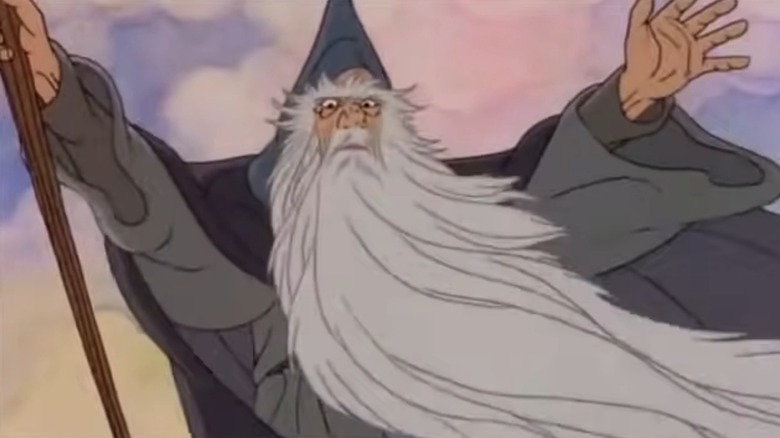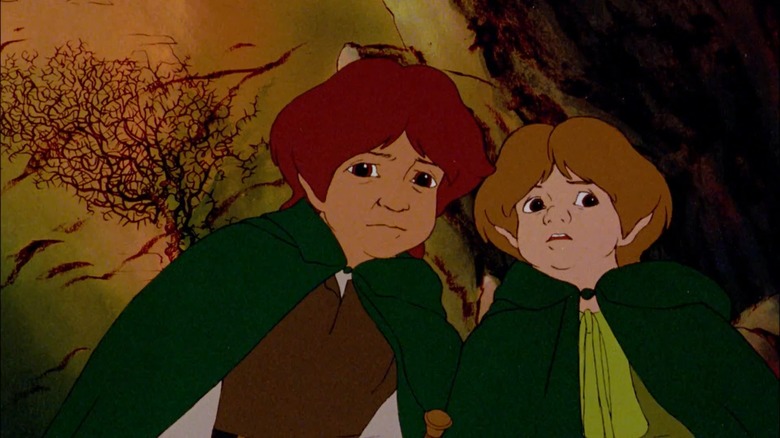5 Obscure Lord Of The Rings Movies & TV Series Only Huge Fans Remember
In the early 2000s, director Peter Jackson stunned audiences across the globe with his blockbuster "The Lord of the Rings" trilogy, breathing new life into J.R.R. Tolkien's legendary fantasy epic. Because of the incredible critical and commercial success this trilogy achieved, it's hard to believe that "Lord of the Rings" was once considered unfilmable and had been a thorn in Hollywood's side since the mid-1950s.
A Hollywood team actually began working on a "Lord of the Rings” film adaptation back in 1956, eventually producing a 55-page treatment that Tolkien himself ridiculed for its numerous changes to his book. This project was quickly shelved, and over the next four decades there would be countless failed attempts to adapt "Lord of the Rings" into a film or television series — including one ill-fated production that would have starred the four members of The Beatles.
Although this troubled history eventually culminated in one of the most popular movie franchises of all time, there were actually several "Lord of the Rings' films and television series that did make it all the way through production, premiering decades before Peter Jackson's magnum opus. Here are a few obscure "Lord of the Rings" films and TV series that only diehard fans might remember.
Rankin/Bass adapted The Hobbit for television in 1977
In 1977, the now-defunct production company Rankin/Bass Animated Entertainment produced a television movie based on J.R.R. Tolkien's "The Hobbit," which serves as a prequel to "The Lord of the Rings."
The film was directed by Jules Bass and Arthur Rankin Jr. and presents a very condensed version of "The Hobbit" that clocks in at just 77 minutes long. This stands in stark contrast to Peter Jackson's "The Hobbit" series, which is probably better than you remember but still stretched the book into three separate movies. The film aired on NBC to generally mixed reviews but earned a Peabody Award for Bass and Rankin. Because of its short runtime, the film makes some drastic changes to the story originally put forth in the novel, including dropping the Arkenstone and Thorin Oakenshield's (Hans Conried) obsession, cutting out Beorn the shapeshifter, and killing off Bombur (Paul Frees), a dwarf who survives in the book.
Although this particular production is not based on "The Lord of the Rings," it marks an important milestone in the Hollywood adaptation of Tolkien's work — especially since Rankin/Bass would actually create their own "Lord of the Rings" adaptation later on.
United Artists partnered with Ralph Bakshi for 1978's The Lord of the Rings
Perhaps the most famous "Lord of the Rings" adaptation to proceed Peter Jackson's trilogy is the 1978 animated film "The Lord of the Rings," which was directed by Ralph Bakshi and released by United Artists.
Bakshi is a prolific animator well known for directing adult animated films during the 1970s and 1980s, including the post-apocalyptic fantasy film "Wizards" and the X-rated "Fritz the Cat." What makes this animated film so unique is the fact that Bakshi used a process called "rotoscoping" (tracing over live action video to transform the footage into hand-drawn animation with realistic, lifelike movement) to animate "The Lord of the Rings." The film includes several notable differences from the book series, including the fact Arwen and Faramir are completely cut from the story along with the Hobbits' journey through the Barrow-downs.
Because the film was originally planned as part one of a two-part adaptation, "The Lord of the Rings" also ends just after the Battle of Helm's Deep, with Frodo Baggins (Christopher Guard) and Samwise Gamgee (Michael Scholas) just starting their journey to Cirith Ungol. When the film grossed just $30 million, United Artists decided to scrap the planned sequel.
Rankin/Bass adapted Return of the King in 1980, this time for ABC
Following up on their successful television adaptation, Jules Bass and Arthur Rankin released another television film, titled "The Return of the King," in 1980, which adapted the eponymous final part of the "Lord of the Rings" novel.
The film aired on ABC in 1980, and is not actually an official sequel to Ralph Bakshi's "The Lord of the Rings" film, despite picking up almost exactly where that film left off. The film opens at Bilbo Baggins' (Orson Bean) 129th birthday party in Rivendell, where he asks his nephew Frodo (Orson Bean) why he is missing a finger. At this point, the movie cuts to a flashback that takes us through the events of "The Fellowship of the Ring" and "The Two Towers," all the way up to Frodo's imprisonment in Cirith Ungol. From there, the rest of the film plays out in a similar fashion to the novel, even including a scene with the Mouth of Sauron that was only featured in the extended version of Peter Jackson's trilogy.
Despite being slightly longer than Rankin and Bass's "The Hobbit," this film suffered a similarly lukewarm reception from critics and fans alike, with particular criticism being aimed at the film's lighter tone and musical numbers.
A Soviet adaptation of Lord of the Rings resurfaced in 2021
Although some fans have undoubtedly seen these classic animated films before, even the most committed "Lord of the Rings" fans would have a hard time finding the next entry on this list, especially since it only became widely available in 2021.
Broadcast in 1991 by Leningrad Television (eventually succeeded by the network 5TV), the television play "Khraniteli" is a Russian-language adaptation of "The Fellowship of the Ring." The first thing that jumps out about this two-part adaptation is its extremely low production quality, as the film is filled with shoddy special effects and costumes that would look at home in a high school play. Despite this low production value (or perhaps because of it), "Khraniteli" is noteworthy for adapting practically every single plot point from the original book. This includes the Tom Bombadil and Barrow-downs storylines, which were both cut from Peter Jackson's trilogy.
This legendary Soviet Union take on "Lord of the Rings" was thought to be lost to time before 5TV uploaded both parts of "Khraniteli" to its official YouTube channel in 2021. Although the production value doesn't stack up to other entries on this list, this one-of-a-kind adaptation is something that every lifelong Tolkien fan should watch.
A Finnish Lord of the Rings adaptation took some major creative liberties
If you thought a lost Soviet-era teleplay of "Fellowship of the Ring" was the most eccentric "Lord of the Rings" television series out there, you would be mistaken. In 1993, the Finnish television network Yle TV1 broadcast a miniseries titled "Hobitit," which was directed by Timo Torikka.
Despite its name, the series is actually an adaptation of "The Lord of the Rings," narrated by an elderly Samwise Gamgee (Pertti Svelholm), who is recounting his story to a group of Hobbit children. The miniseries is full of baffling costume choices and sets, with Boromir dressing like a samurai and wielding a katana and Sauron being depicted as a large human eye in the depths of Mount Doom.
Also odd is the story structure itself, since after the Fellowship leaves Rivendell, the series exclusively adapts the journey of Frodo Baggins and Sam, excluding all other events that they were not present for. This Finnish miniseries is a shockingly faithful adaptation of the book, including many scenes that were cut from Peter Jackson's trilogy and the animated films that preceded it. To this day, "Hobitit" remains the only live-action "Lord of the Rings" adaptation to feature the Scouring of the Shire, wherein Frodo and Sam return home to find the Shire burned and desolate.





